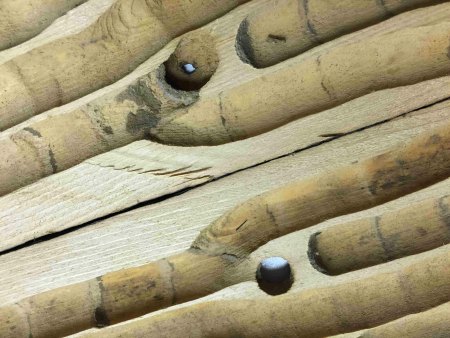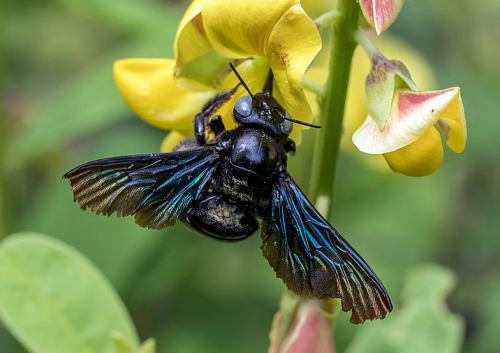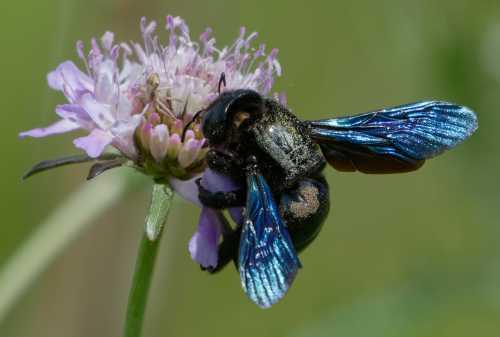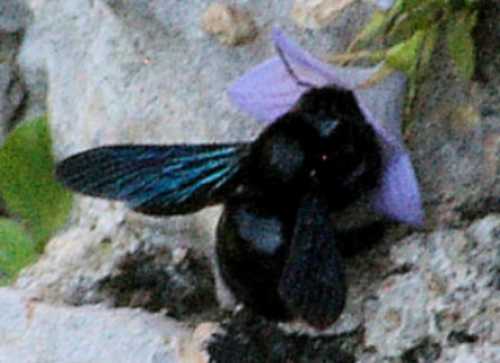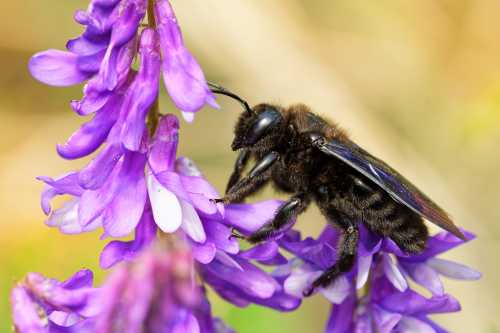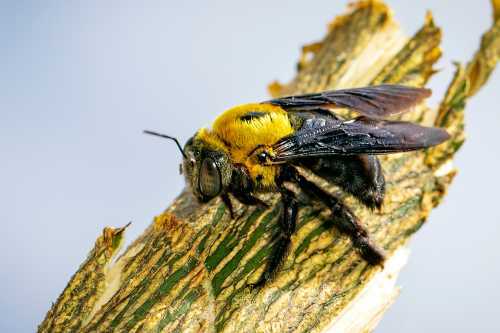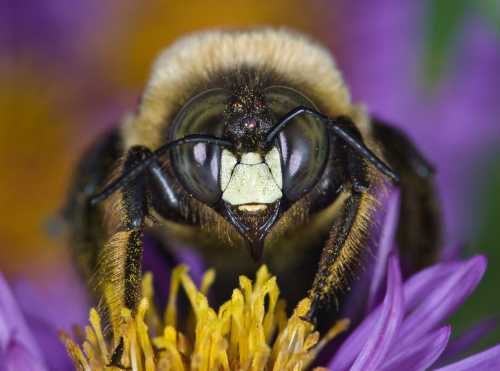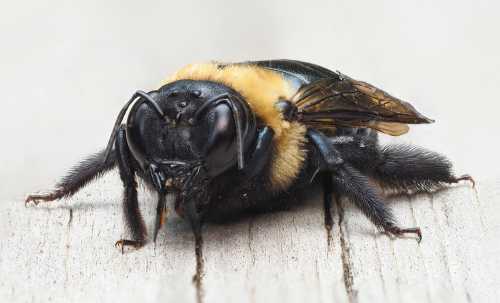What Is A Carpenter Bee?
About carpenter bees (Xylocopa)
Carpenter bees belong to the bee family ‘Apidae’. These species can sometimes be mistaken for bumble bees, although their life cycles and nesting habits are quite different.
The scientific name for bees belonging to this genus (type) is Xylocopa.
What Is A Carpenter Bee?
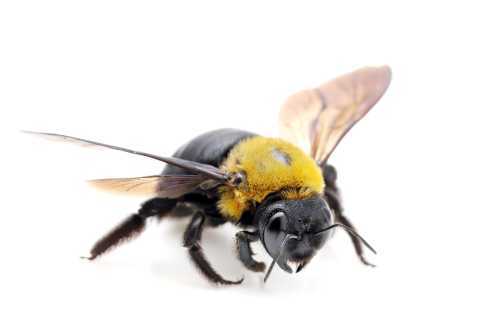 Eastern Carpenter Bee - Xylocopa virginica - found in North America and Canada
Eastern Carpenter Bee - Xylocopa virginica - found in North America and CanadaCarpenter bees are big bees and many species have a dark abdomen, although there are exceptions.
For example, the male of the western carpenter bee, Xylocopa varipunctata has golden-ginger hair, whereas its female counterpart is completely black.
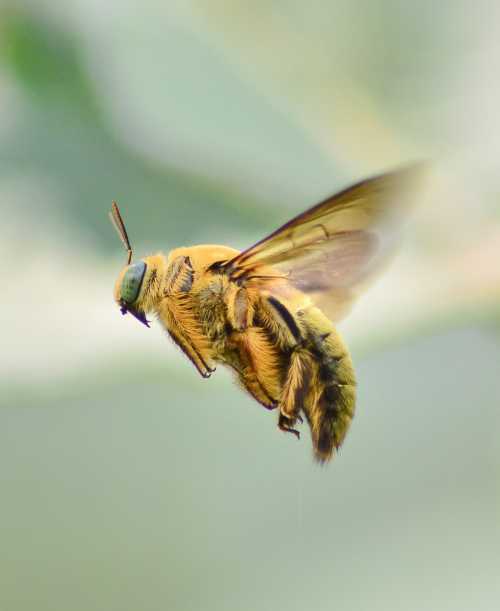 A male Xylocopa varipunctata - also known as the Valley carpenter bee
A male Xylocopa varipunctata - also known as the Valley carpenter beeMore than 500 species of Xylocopa are known to exist worldwide, and whilst most are found in tropical and sub-tropical regions, they are also found in the USA, Canada, and Europe1.
Some species are of conservation concern, or extinct in certain regions. For example Xylocopa valga is critically endangered in Poland, and extinct in Latvia and Lithuania2.
The Violet carpenter bee, Xylocopa violacea, is generally found in southern Europe, although it has recently been discovered in the UK.
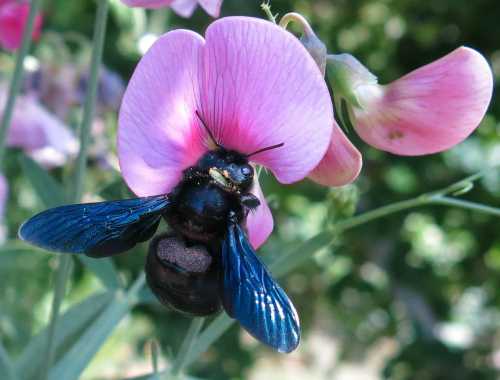 Above: Violet Carpenter Bee - Xylocopa violacea.
Above: Violet Carpenter Bee - Xylocopa violacea.Carpenter bee lifecycle and nesting habits
Typically, females emerge in spring. Suitable nest sites may include, for example a tree trunk or rotting timber.
Not surprisingly, these bees get their name because they are known to make their nests by boring holes in wood. In fact, Xylocopa is the Greek word for "wood worker"1.
The female will begin excavating a tunnel into her chosen nest site, using her powerful mandibles (teeth) to bite her way through the soft wood. Small amounts of sawdust may be visible around new nest sites, although old nest tunnels may be re-used.
In many Xylocopa species, males attract mates with pheromones secreted from mesosomal glands6.
Fertile females lay relatively large eggs along a tunnel, each in its own 'compartment', using masticated wood she has chewed away, to form partitions.
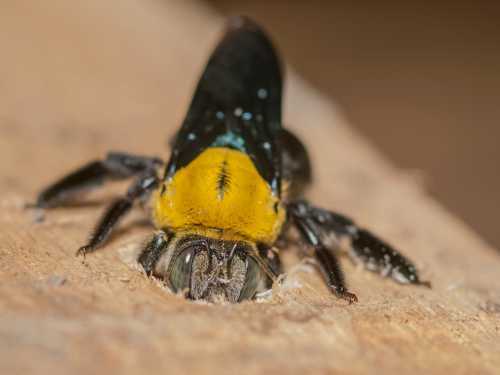 Carpenter bee excavating her nest tunnel
Carpenter bee excavating her nest tunnelEach egg is provisioned with pollen, and progresses through the phases of larvae and then cocoon before emerging as a new adult4. During this process, the immature offspring are guarded by their parent, and newly emerged adults are fed by trophallaxis (mouth to mouth).
In some species, helper females participate in offspring care rather than nesting independently, thus nesting can be social3.
The offspring are fully developed by the autumn. They forage for nectar and pollen before overwintering in the same nest in which they were born1, although they may emerge on warm winter days to forage3.
The following spring, the young females emerge and find nest sites of their own1.
Some species are univoltine (producing one brood in a season - see 'Bee Life Cycles'), whereas others produce more than one brood per year, and the activity season of carpenter bees spans 8–12 months, depending on species3.
As an aside, there is a subgenus of Xylocopa - the Proxylocopa, that nests in the soil. Proxylocopa is reported to contain 16 species, mainly distributed in Albania, Greece, East Israel, and the desert areas of Western China4.
Carpenter bee habitat - where do carpenter bees live?
Abundance and distribution of carpenter bees may depend on availability of suitable nest site provision4.
Some species such as Xylocopa virginica demonstrates distinct nest habitat preferences, whilst Xylocopa ordinaria (found in Brazil) exhibit some flexibility in their choice of suitable plant matter and wood for nests5.
Foraging preference of carpenter bees - which flowers do carpenter bees like?
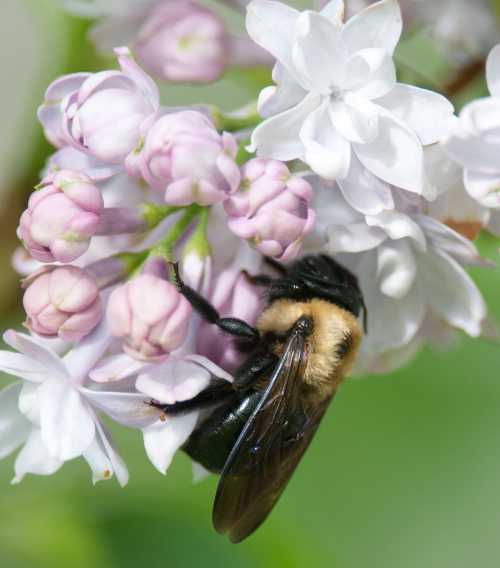 Eastern Carpenter Bee - Xylocopa virginica
Eastern Carpenter Bee - Xylocopa virginicaCarpenter bees are generalists, meaning they will visit a wide range of flowers1.
However, they may visit the same species of flower repeatedly (referred to as 'flower constancy') as they provision their brood cells with food for developing larvae5.
Pollination
The crops pollinated by carpenter bees include passion fruit, Brazil nuts and cotton. They are known to buzz pollinate.
In Australia, some experimentation in commercial greenhouses has taken place, using their native Xylocopa species to pollinate tomatoes. However, the use of carpenter bees for commercial pollination may not be practical due to the difficulties in rearing sufficient carpenter bees3.
Carpenter bees may also engage in nectar robbing.
Natural predators and parasites
The presence of predators depends on location and species of carpenter bee. However, in general, natural predators include birds, particularly woodpeckers and bee-eaters, mantises, robber flies and bee flies.
Read More About Carpenter Bees
References
1. Wilson & Messinger Carril - The Bees In Your Backyard, A Guide To North America's Bees, 2016.
2. He C, Zhu C (2020) Nesting and foraging behavior of Xylocopa valga in the Ejina Oasis, China. PLoS ONE 15(7): e0235769. https://doi.org/10.1371/journal.pone.0235769
3. Tamar Keasar, "Large Carpenter Bees as Agricultural Pollinators", Psyche: A Journal of Entomology, vol. 2010, Article ID 927463, 7 pages, 2010. https://doi.org/10.1155/2010/927463
4. Chunling He, Chaodong Zhu, Nesting Biology of Xylocopa xinjiangensis (Hymenoptera: Apidae: Xylocopinae), Journal of Insect Science, Volume 18, Issue 4, July 2018, 2, https://doi.org/10.1093/jisesa/iey061.
5. Bernardino AS, Gaglianone MC. Nest distribution and nesting habits of Xylocopa ordinaria Smith (Hymenoptera, Apidae) in a restinga area in the northern Rio de Janeiro State, Brazil. Revista Brasileira de Entomologia 2008; 52: 434–440.
6. Duff, 2018. Reproductive behaviour of male Xylocopa virginica and the influence of body size, nestmates, and siblings on territory defence.
If you found this page helpful or interesting, I'd really be grateful if you would share it with others - if not this page, perhaps another, such as Gardening For Bees.
Thank you so much :) .
